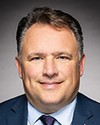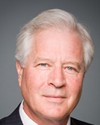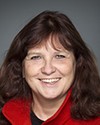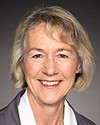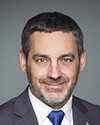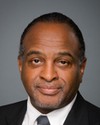Hello ladies and gentlemen. I am very happy to be here today.
I would like to thank this important committee for inviting me here today to talk about the 150th anniversary of our great country, and also to thank the committee for your proactive approach and early consideration for what will undoubtedly be a celebration to excite all Canadians and astound the world.
As a living memorial to the Fathers of Confederation built at the birthplace of our great nation, the Confederation Centre of the Arts pays a lively tribute to Canada's founding and ongoing development as a nation. Our representation is reflective of the achievements that began with the Charlottetown Conference of 1864, and encompass the evolution of each and every Canadian province and territory.
The dream of an architecturally stunning national arts centre located in the highly sought out national and international tourist destination came to fruition in 1964. Located in Prince Edward Island, the Confederation Centre of the Arts is a multi-functional professional arts facility.
Recognized internationally for its contributions to Canada's performing arts, the centre offers four theatre facilities that can house up to 2,500 people. The centre is also home to the Confederation Centre art gallery, with 35,000 square feet of space and a permanent art collection of over 16,000 works of art.
As a whole, the centre offers countless programs for art education and training of children and youth, including a new school for the performing arts. Volunteerism through the Friends of the Confederation Centre of the Arts, and extended through the staff in our daily practice, is our way of life.
The centre also operates a gift shop and a restaurant and services large conventions and banquets. Annually 250,000 people of all ages participate in the centre's programming.
The centre is home to the Charlottetown Festival and Canada's longest running musical, Anne of Green Gables—The Musical, which has drawn millions of visitors from around the world to P.E.I. We have toured Anne extensively across Canada, the U.S.A., England, Germany, and Japan.
The festival, which opened in 1965, has produced over 70 original theatre productions and employs actors, dancers, musicians, and artistic creators and directors from across the country.
Today the centre is governed by a national board of directors representing almost every Canadian province and territory. It is committed, through heritage and the arts, to engage and empower the imagination of our youth and their unique ability to learn; to honour and build on the vision of the founders of Canada; to strengthen our national identity; and to increase the culture and economic wealth of all Canadians. All of this culminates in a vibrant facility serving Canadian and international communities, while stimulating minds and enriching lives.
The Confederation Centre of the Arts has been a cultural leader in many of the celebrations that have taken place in Canada and abroad over the past 48 years. The first was the opening of the centre itself in 1964, a grand affair drawing international attention and a royal delegation. With funds raised from the provinces and matched by Prime Minister Diefenbaker, the centre was opened in October by Her Royal Majesty, the Queen of England, Elizabeth II, with premiers and VIPs present from all provinces, and the Prime Minister of the day, Lester B. Pearson, who stated that:
[The Fathers of Confederation Memorial Building] is a tribute to those famous men who founded our Confederation. But it is also dedicated to the fostering of those things that enrich the mind and delight the heart, those intangible but precious things that give meaning to a society and help create from it a civilization and a culture.
In 2004 the centre celebrated its 40th anniversary as Canada's national memorial to the founding. The Charlottetown Festival was a major component of the 40th anniversary celebrations. One of the highlights in July of that year was a tribute to all of the stars who were on our stages and in our galleries, including the late Norman Campbell, one of the co-creators of Anne of Green Gables—The Musical.
The same year, the centre initiated an exciting new heritage program, the Symons Medal and Lecture Series. This annual lecture features prominent Canadians focusing on national issues such as politics, business, arts and culture, and heritage.
The National Vision Committee seeks to expand Canadians' understanding of the centre's national purpose and significance and to strengthen its capacity to contribute further to the Canadian community and Canadian unity.
In 2007 our youth chorus performed in front of thousands of war veterans, dignitaries, and international media in France at the official dedication of the restored Canadian national memorial at Vimy Ridge. They have been invited to participate again in the 100th anniversary ceremonies of the battle of Vimy Ridge in 2017.
In 2008 we celebrated the 100th anniversary of the publishing of the novel Anne of Green Gables, by Lucy Maud Montgomery. Everyone went behind the scenes of the beloved musical, to meet with the cast and crew and to hear a free orchestra presentation of the musical score of Anne.
In 2010 the Olympic Winter Games in Vancouver showcased Canadian heritage, Canadian achievements, Canadian belonging, and Canadian pride, and we were thrilled to have the opportunity to be a part of that amazing event. As the secretariat for what the media called the “gold medal cultural pavilion”, the centre helped to lead the events management, marketing and communications, staffing and programming that helped to present Canada to the world. Hundreds of Canadian artists and artisans were featured. The centre presented on an international stage, participating in a cultural Olympiad, which was broadcast live to 30 million viewers worldwide.
In 2011, as part of the Cultural Capitals of Canada partnership, our Confederation Centre Young Company was thrilled to present the first ever all-first-nations cast at the Charlottetown Festival, The Talking Stick, written by first nations playwright Cathy Elliott.
The success of these past celebrations has some common themes; that is, the compulsion of community engagement at the grassroots level, recognition and celebration of our founders and their bold imaginations, and thinking beyond our borders, whether those borders be provincial or national or simply beyond the borders of our imagination.
The path to 2017: Contributing to the branding of Canada as an arts nation, both on the national and international scene, is interwoven through everything we seek to achieve for this very important celebration. This is our opportunity to give substantially to each other things that enrich the mind and delight the heart, those intangible but precious things that give meaning to a society and help create from it a civilization and a culture. Our vision for 2017 is a grassroots movement that inspires every Canadian by honouring our past, celebrating the present, and planning for the bold future of Canada's artistic and cultural offerings.
In 2014 the centre will be celebrating its own 50th anniversary and the 150th anniversary of the first meeting of the Fathers of Confederation at the Charlottetown Conference. Plans are under way to mark these momentous occasions and encompass all of Canada in the celebrations. Such plans are precursors to Canada's 150th birthday in 2017, and I expect they will include a new theatre pavilion, meeting national building and safety codes; the creation and production and tour of the next great Canadian musical; a national commemorative sculpture erected on the centre's plaza; enhanced presentation of CANADA ROCKS! , the hit musical revue featuring well-known Canadian performers; the expansion of the Symons Medal and Lecture Series to involve multiple Canadian leaders; a book and a television documentary highlighting the many outstanding activities carried out by the centre; and the presentation of the Confederation Players, a group of students who portray the Fathers of Confederation present during the 1864 conference. Several of these projects will come to fruition in 2014, with the objective of living on through to 2017. Others will just gain momentum in 2014, with plans to launch them during the sesquicentennial.
The 150th birthday of Canada needs to focus not only on the history of one of the world’s most celebrated and beloved countries and the contributions of iconic Canadians, but also the future of the country as a nation the world looks to as a model. A theme might be “from there to here, moving forward to a bold new future”. The wonderful imaginative logo created by the Governor General’s Performing Arts Awards Foundation, as shown to us by Doug Knight at the Arts Summit in Banff this past weekend, should be made available as soon as possible to all Canadians so they can use it everywhere in their daily lives.
In a country that was built by the railroad, galvanized by the national highway, and now instantly linked by the information highway, the Canada of the future looks forward to new trails and inroads blazed by collaborative innovations in arts, culture, and science. For me, this logo represents all of that and more.
The possibilities and approaches to engage Canadians are vast and almost endless. Campaigns and outreach initiatives should be multi-tiered and should take place at the grassroots level and at regional, provincial, and federal levels. When history is expressed through artistic interpretation, learning becomes a pleasure. At the centre we express ourselves through the visual and performing arts. We are considering a number of theatre projects, which we are convinced all Canadians and visitors will enjoy. Among the projects being considered for 2017 are 1864: The Musical, an inventive take on the founding of Canada populated by characters like Sir John A. Macdonald and D’Arcy McGee; Remember to Keep Dancing, a tribute to innovative Canadian choreographer, director, and theatre pioneer Alan Lund; and We Are Canadian!, an extension of the series of plays written for the Confederation Centre Young Company, which celebrates the lives and cultures of all Canadians.
The Confederation Centre has undertaken a legacy project that will not only will celebrate the 150th anniversary of Canada, but will distinguish Canada as a world leader in art, music, and technology. Our project is “The Next Great Canadian Musical”, a theatrical event that promises to redefine live performance in our country and around the world. It will challenge our citizens to cooperate for a productive, healthy, socially and culturally integrated future, and will honour the abundance of our natural resources. We are partnering with established playwrights, poets, musicians, technicians, choreographers, and designers to construct an original theatrical context.
We are also in the early stages of developing a major visual arts exhibition concerning architectural projects that were prepared as part of Canada's program of centennial celebrations during the 1960s. As you are all aware, projects commemorating the 1967 centennial of Confederation were sponsored by all levels of government. Despite their role as markers, these projects were not nostalgic, but rather expressed Canada's desire to be understood as a modern, progressive, forward-looking nation entering its second century. As such, they constitute an important documentary record of the national identity, values, and aspirations of the day.
Since the Confederation Centre of the Arts was the first federal centennial project to be completed, in 1964, this exhibit would help celebrate our 50th in 2014, tour nationally between 2014 and 2017, and finally culminate in an exhibition at the National Arts Centre in Ottawa, which was the final federal centennial project to be completed, in 1969.
In addition to plans in place at the Confederation Centre of the Arts, there are many initiatives that can take place on a national level.
A live concert simulcast could take place from five major Canadian cities, from the steps of Parliament in Ottawa to the steps of the Confederation Centre of the Arts in Charlottetown, and every capital city in the country. We should include Canadian embassies around the globe; there are 2.8 million Canadians living outside of Canada. The concert could showcase the best in Canadian talent, telling the story of Canada to date as well as visions of the Canada of tomorrow.
Educational programs could be built into school curricula to give an innovative, fresh perspective on the history of Canada, and to reinforce learning and critical thinking as part of our culture. Students of all ages could participate in an essay contest on why it's great to be a Canadian. The contest could be run across the country, with the winner reciting their essay on the steps of Province House in P.E.I. during a national broadcast.
Totem poles could be commissioned in each province, telling the history of their region. Time-lapse videos could be produced and broadcast. A possible partner might be Aboriginal Affairs and Northern Development Canada.
New Canadians, part of our proud multicultural society, could be celebrated across the country with a synchronized swearing-in ceremony. This might be a live webcast or TV broadcast. We would be happy to host it on our plaza.
Canada Day celebrations might include a national drum circle, with artists representing Canadian cultures on our plaza, each representing a different Canadian culture, whether that be Celtic, aboriginal, classic, or ethnic.
Vignettes could be produced with children telling stories that have been passed through their families dating back to the generations from the time of Confederation. The videos could be made available for all Canadians.
Volunteers from local communities will participate, as will not-for-profits and the public and private sectors across the country.
The Confederation Centre of the Arts is a national institution and is ideally suited to host activities for the 150th. Situated in the cradle of Confederation, it is not only Canada's only national memorial to the founding of the nation, it is a well-oiled machine teeming with talent and ability. We are ready to be a major participant in the 2017 celebrations. We have the experience. As host to millions of visitors for the past 48 years, we know how to host a party, whether it be in Charlottetown, another place in Canada, or any place in the world.
I sincerely thank each and every one of you for providing me with this opportunity to join you in this dialogue about how we might celebrate Canada's 150th birthday; how all Canadians can give Canada many gifts; how birthday parties in communities across the nation will take place and set us on a path that unites us, celebrates our unique heritage and culture, and our prominent position on the world stage; and how blessed we are, as we enter our next 150 years, to create a future that is innovative, transformative, stimulating, and above all, one that is Canadian.
Thank you very much.

